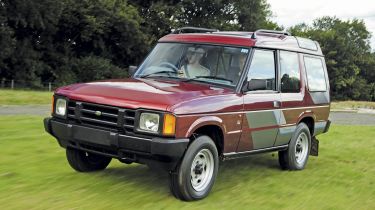Land Rover Discovery 2.5 TDi
Groundbreaking SUV remains a mechanical masterpiece today
In the Eighties, Land Rover had two products: a workhorse and a luxury 4x4. It needed something to fill the gap, and the Discovery was the answer. The newcomer combined Range Rover underpinnings with a more practical body, and broad talents ensured it appealed to everyone from farmers to family car buyers.
Our three-door 2.5 TDi was the first model off the line in 1989 (the five-door followed in 1990), and has never been registered. But our drive off the beaten track was more than enough to understand why it was such a hit.
Its huge body introduced Land Rover’s distinctive stepped-roof shape for the first time, and provides acres of space inside. Some elements of its design haven’t lasted, though, and the side-hinged tailgate was ditched when the latest Discovery 3 arrived in 2004. The biggest news, as far as Land Rover was concerned, was the Discovery’s airy interior, designed by Sir Terence Conran. The layout still feels modern today, although the company raided the old Rover parts bin for its switchgear and the all-blue interior instantly dates our car’s cabin.
There’s nothing wrong with the way the Discovery drives, though. The coil-sprung Range Rover chassis ensures supreme comfort over rough surfaces, while you can maintain healthy speeds over grassy tracks or fields without shaking yourself to pieces – impossible in a leaf-sprung Land Rover.
What’s more, the Discovery has a set of low-range gears and a differential lock, so it’s just as capable when the grass gives way to steep slopes and waterlogged mud. By modern standards, the 19-year-old diesel engine feels lethargic, but considering its weedy 111bhp power output the Discovery is more than capable of dealing with the challenges of modern driving. Just prepare yourself for lots of body roll around bends.
From behind the wheel, creature comforts include power-steering and a proper ventilation system, not to mention a stereo and digital clock. They’re the least we expect nowadays, but for farmers used to driving 90 and 110 Land Rovers, they came as a revelation in the early Nineties.
The Discovery doesn’t have the glamour of the Range Rover or the practicality of the Defender, but it’s still enjoyable to drive off-road. The upright windscreen and once-fashionable interior give it a unique feel – and that, along with its range of abilities, makes it a strong contender in this test.



